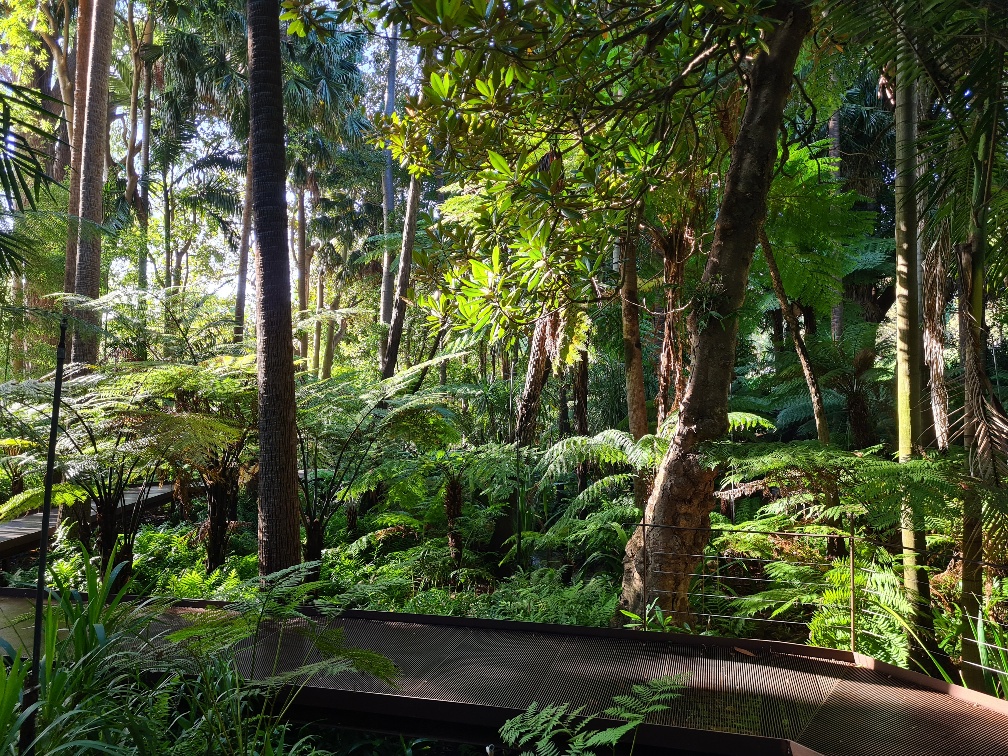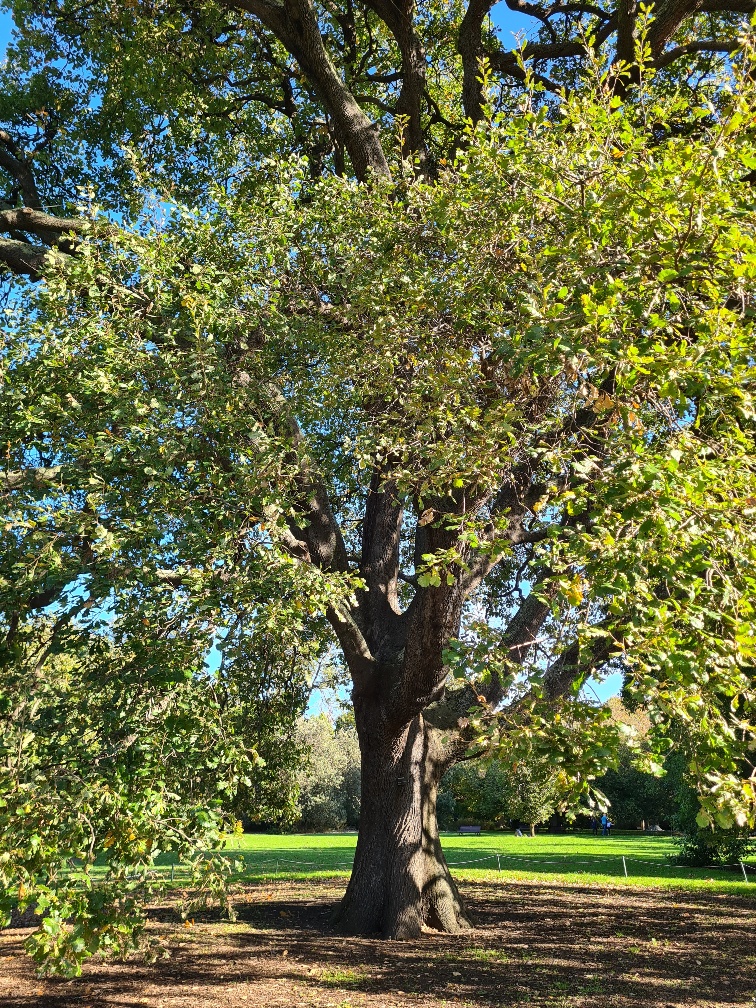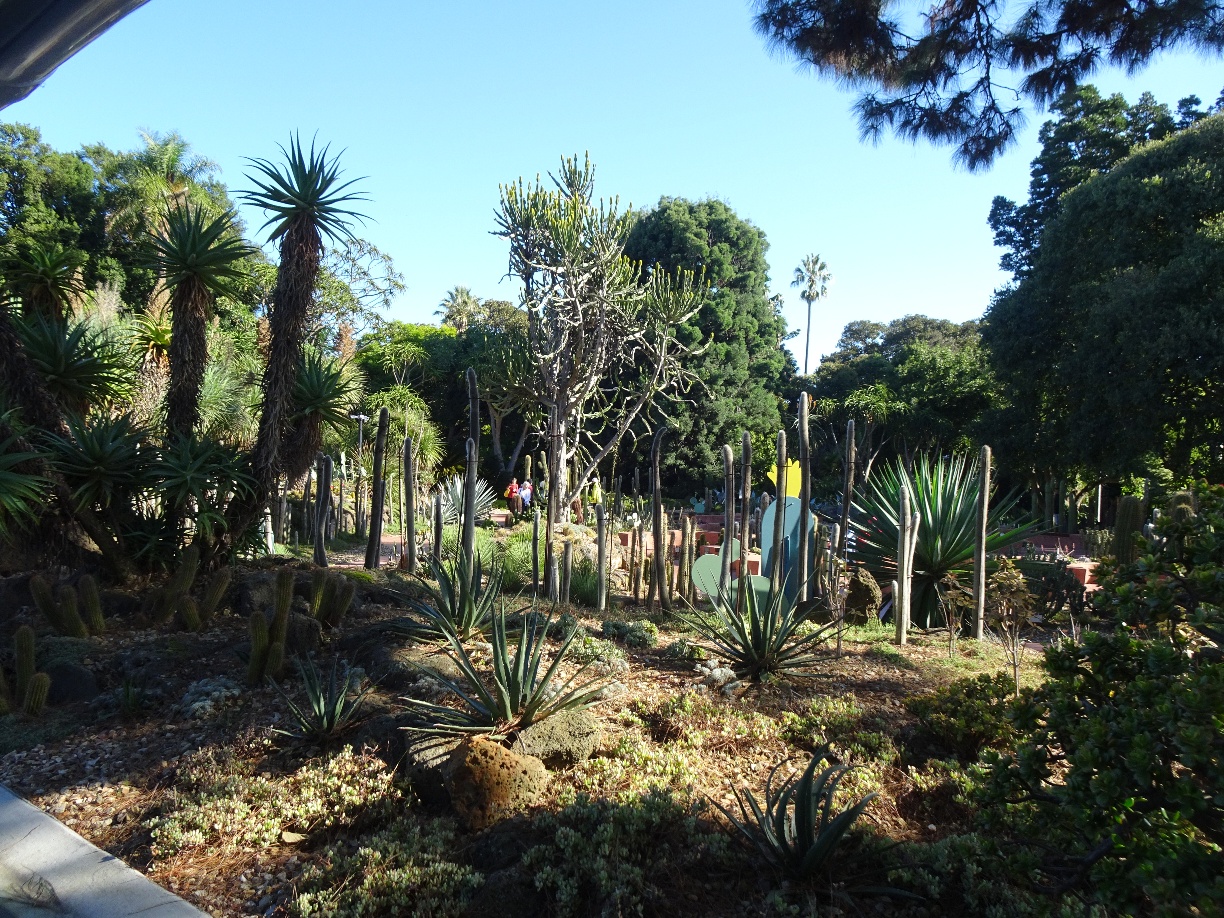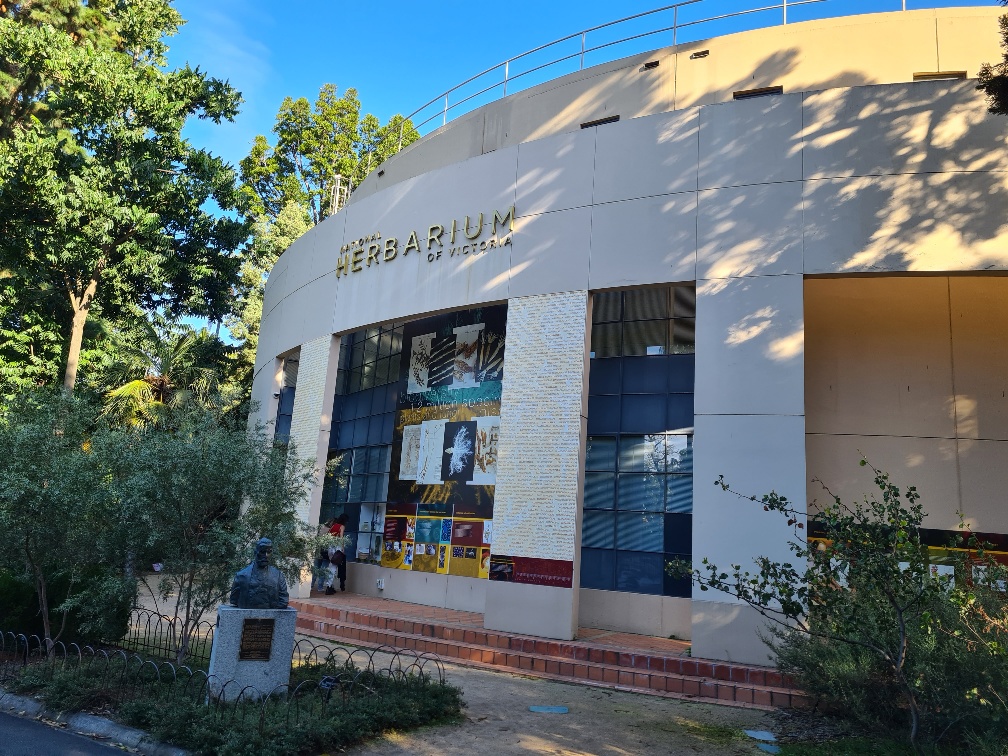Learn English while learning about daily life in Australia, with Rob McCormack
Podcast Number 148 – The Royal Botanic Gardens – Melbourne
(This podcast is 11 minutes and 8 seconds long.)
Hi,
Many Australian cities and towns have a botanic garden near their centre. These gardens are places where people can go to get away from the concrete, the noise and the busy life of the town or city in which they live. However, a botanic garden is more than a park or garden with plants, lawn, trees and open space. It’s a place where the plants are carefully chosen living collections which are cared for and studied by experts in their field, and where members of the public can learn about, and appreciate, the plants in the collections. You may know that a person who studies plants is called a botanist, hence the words ‘botanic garden’, where botanists study plants. In this podcast, I would like to tell you a little about Melbourne’s Royal Botanic Gardens in the centre of Melbourne. https://www.rbg.vic.gov.au/melbourne-gardens/
I would be the first to say that I am not really interested much in studying plants. If you asked me which motorcycle had just passed by on the street, I could probably tell you the make, the model and how much horsepower it has. However, with trees or plants, I am just not that passionate. However, on a recent trip to the Royal Botanic Gardens in the centre of Melbourne, I was amazed how beautiful and peaceful a well-cared for and well-designed garden can be. On the day I visited with my wife, a sunny Sunday, there were many hundreds of Melburnians and tourists of all ages visiting the gardens. On our visit, I got an insight into what makes people passionate about being around plants and in gardens.
The Royal Botanic Gardens are located right in the heart of the city of Melbourne, on an area of land 38 hectares in size. It was established in 1846 and today has around 8,500 species of plants from all over the world, comprising around 50,000 individual plants. There are 23 living collections of plants, including the Cacti and Succulents collection, the Southern Africa collection, the Rare and Threatened Species collection and the Quercus collection (which means oak trees), to name just a few. The gardens contain a wonderful ornamental lake with a variety of small islands which house interesting collections of plants. Walking around this lake is like being part of a watercolour painting from the 1800s. It is so picturesque. It is even possible to get a ride on a punt, a flat-bottomed boat powered by a boatman with nothing more than a big wooden pole, just like the gondolas in Venice.
There are 2 excellent eateries within the gardens where you can buy a meal or a light snack, including (of course) ice cream – which is one of my favourite delights especially on a sunny day such as we had on our visit. When you are relaxing in a botanic garden, the ice cream counter is irresistible.
The plants and the different collections are very well labelled and well maintained. There are some really unusual and remarkable plants there. One of the most interesting collections is the Quercus collection, which comprises oak trees.
This includes the Cork Oak from Portugal, the White Oak from North America and the Algerian Oak from the western Mediterranean. The Botanic Garden’s largest example is an Algerian Oak.
Another collection which caught my eye was the Cacti and Succulents collection. These plants can survive in places where water is scarce. They are commonly found in deserts and other dry regions. Good examples in the Botanic Gardens collection include the Golden Barrel Cactus from Mexico and the Old Man of the Mountain Cactus from the Andes Mountains in South America. The cacti collection is large and their unique shapes and colours are fascinating to look at.
The Southern Africa collection is also full of amazing plants. My favourite is the Tree Aloe which has a really thick trunk leading to many branches which have interesting curves as they get thinner, topped by leaves which look a little like cactus leaves. We certainly have nothing like that growing naturally in Australia.
Of course, there are, in total, 23 living plant collections listed on the Royal Botanic Gardens website, so there are many others to look at as well. https://www.rbg.vic.gov.au/melbourne-gardens/.
Throughout the gardens you get to walk on wide paths which make your stroll so relaxing and easy. I use the word ‘stroll’, because you almost always walk slowly through these gardens – there is so much to see and experience as you go, so walking fast just doesn’t enter your head. There are large areas of well-tendered lawn which encourage people to spread out their picnic rug and sit down to enjoy the atmosphere. On the day we visited, many people were doing just that. The grass is lush and well groomed, so resting and relaxing on the grass is quite comfortable. There are also plenty of benches to sit on throughout the gardens, which visitors appreciate.
It is also very easy to learn about the plants in the botanic garden. You can take a 30-minute tour on their open-sided minibus which meanders throughout the gardens. My wife and I did this and the driver took us to all the major areas of the gardens, providing information and interesting insights at each stop. You can also do a guided walk with an expert guide who can show you all the key collections and provide an interesting commentary. Lastly, you can also do a self-guided tour around the gardens by accessing a website link at https://rbg.vic.gov.au/sonica-botanica/, or by scanning a QR code found at the Oak Lawn Gate in the gardens. The information is very detailed and will be interesting for those of you who love the plant world.
I should also mention that the Royal Botanic Gardens are the home of the National Herbarium of Victoria, which is one of Australia’s most valuable research facilities. It holds over 1.5 million dried plant, algae and fungi specimens. This herbarium allows research scientists to continue their work in understanding and describing the rich variety of plant life we have on our planet.
If you come to Melbourne, I would highly recommend that you visit the Royal Botanic Gardens. You will not be disappointed, even if, like me, you are not a plant enthusiast.
If you have a question or comment to make, please leave it in the comments box at the bottom of this page. Or, you can send me an email at rob@slowenglish.info. I would love to hear from you. Tell me where you live, a little bit about yourself and what you think of my Slow English podcast. I will write back to you, in English of course. If you would like to take a short quiz to see if you have understood this podcast, you will also find it on my website. Goodbye until next time.
Rob
Podcast 148 Quiz - Did you understand the podcast?
You can take the quiz as many times as you like.
Vocabulary
accessing = (here) getting into
amazed = when you are surprised by something or someone, in a positive way
appreciate = (here) to see the good things about something
benches = seats on which several people can sit
cared for = look after
carefully chosen = selected with great care
caught my eye = when you see something which keeps your attention
collections = a group of things kept together, all with something that is common
comprising = made up of, consisting of
concrete = a man-made rock with is grey and hard, buildings are made from concrete
counter = the bench or table in a shop where you buy something
delights = things which make you happy (usually food such as cake, ice cream or sweets)
eateries = cafes, restaurants – places where you can eat
enthusiast = a person who enjoys doing something
established = (here) started
experts = people who know a lot about one topic
facilities = machines or buildings which help you to do a certain thing
fascinating = when something is very, very interesting
gondolas = the type of boats they have in Venice, Italy
hectares = an area equal to 10000 square metres
hence = therefore
herbarium = a place where plant specimens are kept and studied
horsepower = the amount of power an engine has
individual = separate, single
insight = understanding
irresistible = you can’t resist something, you must have it
labelled = when the name of something is written down on it or next to it
lawn = an area where grass is growing and it is cut using a lawnmower
lush = when plants grow really well
maintained = looked after
meanders = goes around curves slowly
noise = a sound which doesn’t sound very good
ornamental = made to look good
passed by = when something goes passed you
passionate = to love something or to love doing something
peaceful = when everything is quite and you’re are not stressed
picnic rug = a rug which you put on the ground for a picnic
picturesque = very pretty, usually when talking about the landscape
pole = a long piece of thin wood
rare and threatened species = a type of plant or animal that is in danger of disappearing forever
relaxing = when you are not worrying about things, without stress (usually when you are not working)
scarce = when there is a shortage, when something is hard to get or hard to find
self-guided = when you don’t need a guide, you have the information you need
snack = something small that you eat between the main meals of the day
specimens = animal or plant examples, used for study
stroll = to walk very slowly
studied = to learn about something
succulents = a type of plant
topped by = when something is at the end of something else
trunk = the thickest part of the tree which comes from the ground
unique = when something is like nothing else
variety = different types
watercolour = a type of painting used by artists
well-designed = when something is really well made according to certain rules
well-tendered = well looked after








February 25, 2024 at 9:39 pm
hi , thanks for your good courses.
i am from iran and now living in tehran
i saw your web site today
it is very good and useful
February 25, 2024 at 10:29 pm
Hi Roshan,
Many thanks for your comment. I’m glad that you find my podcasts useful.
Have a great day.
Rob.
September 19, 2023 at 2:33 am
Hi Rob. My name’s Gonzalo. I’m Spanish from Seville. I’m 85 years old and I’m studying English by myself. I’m started to read and listening to your podcasts and I’m very lucky because I understand almost everything of what you write and say in your podcasts.
Thank you very much and I hope you keep on doing this wonderful work.
Long life for you and your family.
GONZALO
September 19, 2023 at 8:35 pm
Hi Gonzalo. Many thanks for your comment. I am impressed that, at 85 years of age, you are learning a new language. That’s wonderful. It’s a great way to keep your brain working effectively, and also a fun activity. I hope I can also be learning actively if I get to 85 years of age.
Best regards,
Rob.
September 13, 2023 at 10:48 pm
Hi Rob, I’m an international student in Melbourne. Last weekend, we visited the Royal Botanic Garden. When I wanted to learn more about the garden from Snipd, I found your podcast. I was pleasantly surprised to discover this lovely podcast! It’s really useful for ESL learners. I was amazed when I discovered that the first episode was made 11 years ago. Thank you so much for making the podcast.
Spring is here, and the next time I go to the Royal Botanic Garden, I will try the ice cream.?????
(I used to major in plant science, however, after coming to the Southern Hemisphere, there are too many plants I don’t recognize, haha.?
Best regards,
Skye
September 14, 2023 at 8:17 am
Hi Skye,
Many thanks for your comment. I’m glad you found my podcast. Yes, I have been making my podcast for a long time and I still enjoy receiving wonderful comments such as yours. I hope you are enjoying life in Melbourne. I can certainly recommend the ice cream, especially now that warmer weather is coming.
Have a great day.
Rob.
May 14, 2023 at 8:42 pm
Hi Rob,
I would be the first to say that you had been doing a great job, publishing your podcasts consistently. Well done and many thanks for the hard work.
Like you, although I am not an expert in botany, I have always had a keen interest in plants. So when I visited Hobart, the capital of Tasmania, in March this year, my first choice was the Royal Tasmanian Botanical Gardens. Which is Australia’s second oldest Botanic Gardens and with a number of unique collections such as Australia’s only Subantarctic Plant House, and with Lily Pond, the Anniversary Arch, Japanese Garden, and so on. Its unique is the extensive Tasmanian native collections , which provide real live plant examples. Especially areas of the Gardens are available for hire for private functions. Anyway, what I remember most about Tasmania is the beauty of the Gardens. In the gardens I like getting to walk too on wide paths which make my stroll so relaxing and easy.
Best regards,
Dep from Hangzhou China
May 14, 2023 at 10:02 pm
Hi Dep,
Many thanks for your comment and your kind words about my podcast. I too have been to the Botanic Gardens in Hobart and they are indeed excellent.
I hope you and your family are well.
Best regards,
Rob
May 5, 2023 at 11:22 pm
Thank You Rob for the amazing podcast. Have a lovely weekend.
May 6, 2023 at 3:58 am
Many thanks Evan for your comment. Much appreciated. Have a great day. Cheers from Melbourne. Rob.
May 5, 2023 at 11:12 am
Rob, Another wonderful and informative podcast. I have again learned more about the Botanic Gardens from your podcast than I had over the past 70 years!! Keep up the brilliant work! Chris
May 5, 2023 at 11:43 am
Hi Chris. Many thanks for your kind words about my podcast. I am pleased to receive such feedback from a true plant enthusiast! Cheers. Rob.